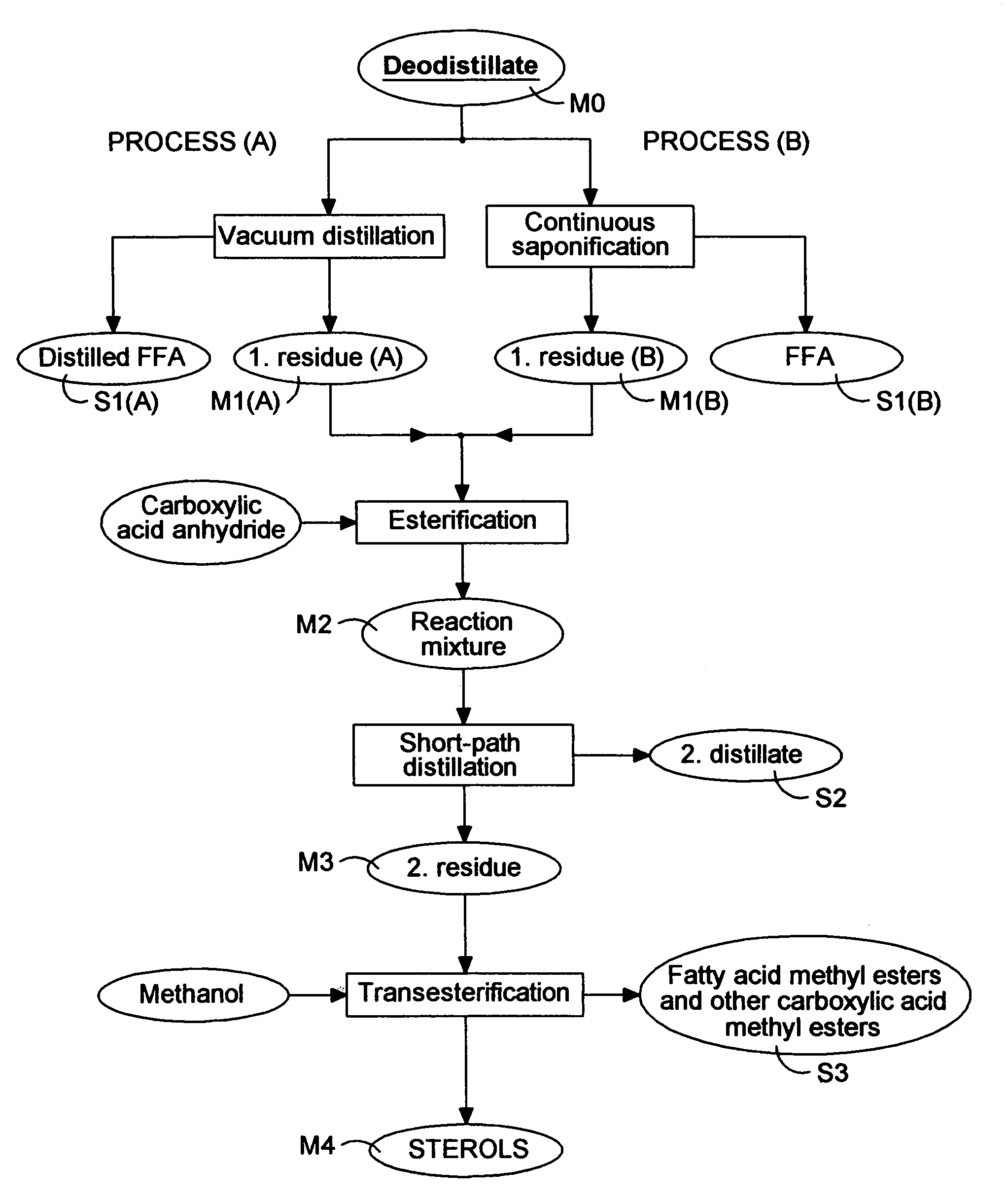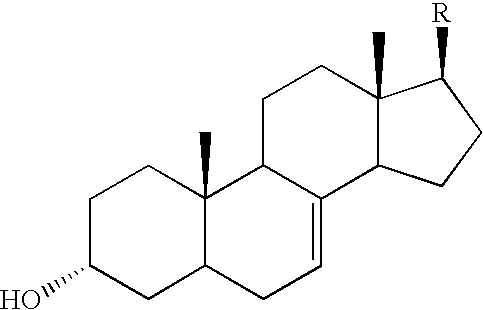Process for recovery of plant sterols from by-product of vegetable oil refining
- Summary
- Abstract
- Description
- Claims
- Application Information
AI Technical Summary
Benefits of technology
Problems solved by technology
Method used
Image
Examples
example 2
[0061]The same deodorization distillate (M0) as in Example 1 was used as starting material in the continuous solvent saponification reaction. The raw material (400 g) was dissolved in 2400 ml hexane. An alkali solution was made from 300 ml sodium hydroxide (concentration: 125 g / l), 400 ml water and 800 ml ethanol. This alkali solution was then added to the deodorization distillate—hexane solution and the mixture was intensively stirred for 5 min at room temperature. Afterwards the whole mixture was transferred into a separation funnel and it was subjected to decantation until two phases formed with sharp phase boundary (4 hours). The two phases were then separated. The upper, apolar phase contained glycerides and the unsaponifiable substances, the lower, polar phase contained the dissolved soaps.
[0062]Both phases have to be washed because of the cross-solubility of the solvents. The polar phase was washed with an apolar solvent (3×100 ml hexane) to improve the yield, the apolar phas...
example 3
[0065]The residue of the first distillation of deodorization distillate (250 g M1-A) was treated with 11 g benzoic acid anhydride (90%, technical, Aldrich), we obtain free sterols from the sterol esters in this way.
[0066]Firstly the distillation residue was heated to 120° C. and then, this temperature was maintained for 1 hour at 10 mbar residual pressure to remove the moisture traces. Afterwards the mixture was cooled to 80° C. and the benzoic acid anhydride was added. The esterification reaction took place at a temperature of 150° C. at 100 mbar residual pressure during 2 hours. The reaction was followed by gas chromatographic (GC) analysis. In the end, we achieved 261 g reaction mixture (M2). The composition of the product is shown in Table III.
[0067]
TABLE IIIMaterial codeM1-AM2Mass (gram)250.0261.0Unit%*gram%*gramFree fatty acid18.7646.9015.8341.32Total tocopherol4.4111.024.1010.69Total sterol7.4218.540.000.00Sterol esters5.6714.1822.1157.71Glycerides48.41121.0347.24123.30*the %...
example 4
[0068]The esterified mixture (250 g M2) was treated in a short-path distiller (0.075 m2) equipped with a heated jacketed dosing funnel and a control needle valve.
[0069]The operation resulted in a second distillate (44 g S2) and a second distillation residue (199 g M3). The distillate obtained in this step is the tocopherol concentrate. The composition of the distillation products is characterized in Table IV.
[0070]
TABLE IVMaterial codeM2S2M3Mass (gram)250.055.0191.0Unit%*gram%*gram%*gramFree fatty acid15.8339.5866.4736.561.142.18Total tocopherol4.1010.2518.5610.210.000.00Total sterol0.000.000.000.000.000.00Sterol esters22.1155.280.200.1128.7254.86Glycerides47.24118.109.875.4358.65112.02*the % values relate to weight %
PUM
 Login to View More
Login to View More Abstract
Description
Claims
Application Information
 Login to View More
Login to View More - R&D
- Intellectual Property
- Life Sciences
- Materials
- Tech Scout
- Unparalleled Data Quality
- Higher Quality Content
- 60% Fewer Hallucinations
Browse by: Latest US Patents, China's latest patents, Technical Efficacy Thesaurus, Application Domain, Technology Topic, Popular Technical Reports.
© 2025 PatSnap. All rights reserved.Legal|Privacy policy|Modern Slavery Act Transparency Statement|Sitemap|About US| Contact US: help@patsnap.com



